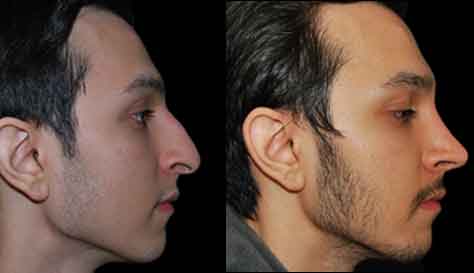Ear Lobe Surgery
Conveniently located to serve the areas of New Jersey and New York

Earlobe appearance is a very important feature for people. Unfortunately, as we age, we fight gravity. This includes earlobes which become lengthened and elongated. Oftentimes, earlobes can appear large and unsightly or torn by accident while wearing earrings. The impact of the earlobe problem can range from a simple annoyance and discomfort while wearing earrings to damage to someones’ self-esteem and
personal image.
Earlobe Surgery Before & Afters
The good news is that you don’t have to live with this problem as it can be quickly corrected by an in-office procedure performed under local anesthesia, which takes minimal time and causes very little discomfort. Patients come in for a consultation with Dr. Ovchinsky where everything is discussed in detail. Once the consultation is complete, the procedure takes place. A followup visit 1 week after the procedure is required to remove stitches.
There are several methods of earlobe repair and earlobe reduction. For torn earlobes, the edges of the tear are prepared by removing the ingrown skin and two parts of the earlobe are brought together with very fine sutures. In cases of large earlobes, a portion of the earlobe is excised in a special way to minimize visible scars and earlobe distortion. Ear lobe reduction surgery can be done in multiple ways which are broadly fall into two categories:
1. By removing a wedge portion of the earlobe and suturing two remaining parts together. The resultant scar will be located on the front and on the back of the earlobe
2. By removing the bottom portion of the earlobe (essentially making the earlobe shorter in the vertical dimension) and closing the resultant defect. With this option, the scar is located in the bottom of the earlobe.
No dressings are required besides topical antibiotic ointment.
A new piercing can be made several months after the surgery. It is generally advisable to await with re piercing for at least six months to allow for the full healing and it’s better to avoid placing a new piercing in the line of prior tear, if possible. Usually, it’s best to avoid wearing heavy jewelry until the full strength of the ear lobe is restored (six months or later).
FAQ
What do I need to avoid before surgery?
If you are on “blood thinners,” you will be asked to stop them approximately one week prior to surgery. We also ask that you avoid certain over-the-counter medications. If you are taking some herbal supplements, you should stop those as well as they may contain blood thinning substances. Also, you have to completely quit smoking at least two weeks before surgery.
What about my daily medications before surgery?
You will have a preoperative appointment well in advance of your surgery when we will review all mediations with you. If you are on “blood thinners,” you will be asked to stop them approximately one week prior to surgery. We also ask that you avoid certain over-the-counter medications. You may continue taking most routine medications up until the morning of surgery with a small sip of water.
What happens after surgery?
You will go to the recovery room for a few hours until you are fully recovered from anesthesia. Once you are stable you will be taken home (or to a hotel) by your family member or a friend. You will want to stay relaxed for the first few days. You will need to keep your head elevated when in bed to help with faster resolution of swelling. You should begin to start walking, eating, and using the restroom the day after surgery. Your activity can slowly increase each day but it will take up to 2 weeks before you start to feel like your old self again. You should avoid any strenuous activity for 4 weeks. You will need to take medication prescribed to you by Dr. Ovchinsky, which usually include antibiotics, pain medicine, antibiotic ointment for the incisions, and occasionally anti-nausea medications.
Are there any dietary restrictions following surgery?
No. Patients can eat whatever they want. Advance your diet from liquids (fruit juice, milk shake, etc.) to soft food (pudding, macaroni and cheese, mashed potatoes and gravy, oatmeal, pasta) to solids as tolerated. To prevent dehydration, please drink as much juices and nutritional fluid as possible.
When will my stitches be taken out?
Stitches are normally removed five to six days after your surgery.
How soon will I be able to exercise?
Dr. Ovchinsky recommends that patients do not return to exercise for three weeks after their procedure.
When will I be able to see the results?
You may see the difference right away, and more so once the swelling goes down within the first one to two weeks. As with any surgical procedure, it takes anywhere from 6 to 12 months for the results to become final.
What is special about the way Dr. Ovchinsky does the surgery?
Dr. Ovchinsky tailors his surgical technique to an individual patient rather than using the same “run of the mill” surgery on everybody. The technique he uses causes minimal pain, has natural results, and is long-lasting. The vast majority of patients are quite surprised afterward at how little discomfort they have and how quickly they return to normal activity. Most patients have minimal bruising. Finally, with Dr. Ovchinsky technique and attention to details during skin closure, scars are typically minimal and are often difficult to see once they have fully matured.







